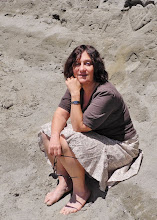 Last night I decided to head on down to Benaroya Hall to hear Greek violinist Leonidas Kavakos with Italian pianist Enrico Pace. This will conclude my eye-witness account of the local music scene facing economic survival for the time being. Passover begins next week, so I'll be pre-occupied with Chometz, the stuff that causes leavening in food and puffing up of the ego, as well as what it means to be liberated. I didn't want to miss Kavakos, especially after reading this quote: "Music is about devotion, and knowing when to be free."
Last night I decided to head on down to Benaroya Hall to hear Greek violinist Leonidas Kavakos with Italian pianist Enrico Pace. This will conclude my eye-witness account of the local music scene facing economic survival for the time being. Passover begins next week, so I'll be pre-occupied with Chometz, the stuff that causes leavening in food and puffing up of the ego, as well as what it means to be liberated. I didn't want to miss Kavakos, especially after reading this quote: "Music is about devotion, and knowing when to be free." I'm an admirer of this unique violinist, having enjoyed his recordings, especially the Ysaye Six Solo Sonatas, over the years. As a violinist myself, I'm grateful that Kavakos is not the cookie-cutter model, like most American players streaming out of Juilliard. To be sure, if Leonidas Kavakos were growing up in Seattle today, the local puffed up "pedagogues" might take him to task for displaying an unorthodox bow hold. They'd probably insist on sending him to "violinist rehab", a place to be molded like everyone else.
Kavakos and Pace presented a program that might have been considered too austere and esoteric for the Seattle crowd. They offered an entire menu of sonatas by Beethoven, Shostakovich, and Richard Strauss. The main floor appeared rather full, but like the last two events that I attended at Benaroya, the tiers were empty, even more so. I suspect the house was papered to a degree. A student I bumped into admitted he had been given a free ticket. Also, clapping occurred between movements, even during Beethoven's Third Sonata, suggesting the audience might have been unfamiliar with concert etiquette. Personally, I see no harm in bursting into applause at the conclusion of a movement—don't opera audiences cheer after a beautiful aria?—but Mr. Kavakos appeared perturbed by the disruptions in his performance. At one point, he wagged his bow like a finger, as if to indicate the audience had been naughty, and to serve as a warning. After the initial movement of the Strauss, he gestured with his hand to prevent applause.
I was surprised to not find more music students, particularly violinists, in the audience. True, Leonidas Kavakos is not a household name in Seattle. However, he conveys an originality of style and mercurial technique seldom heard these days. The collaboration of Kavakos and Pace in the Beethoven Sonata Op. 12 displayed elegance and integrity between both partners. The Shostakovich Sonata Op. 134, a work created for David Oistrakh, casts a gloomy, forboding mood which, to my mind, could serve as commentary for the decline of cultural standards and current affairs. During the second movement, the sinister sounding Allegretto, Kavakos and Pace played as if they were demonically possessed. Theirs was an electrifying performance, which caused this listener to bellow "Bravo".
The program concluded with the Violin Sonata in E-flat Major of Richard Strauss. Although it was played beautifully by both artists, and Kavakos possesses a suave, sumptuous tone, I felt the piece fell short on the Viennese cafe style for which, especially the slow movement, it was conceived. It could have used just a tad more, let's see—how can I word this—schmaltz.
Clearly, if orchestra programs are a tough sell, recitals today are even less in vogue. Perhaps such programs might be better served in smaller venues, as they were originally intended; one misses a more intimate setting.
Photo by Yannis Bournias

No comments:
Post a Comment